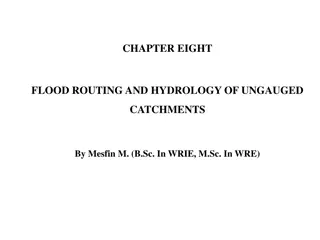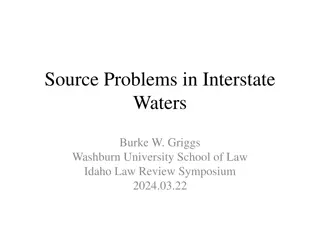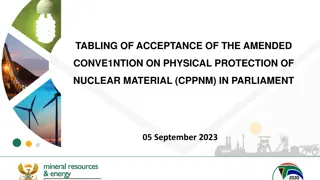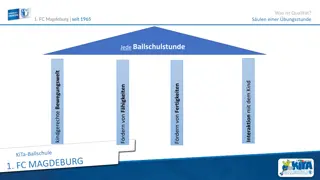Overview of Physical Hydrology and Hydroclimatology
Physical Hydrology and Hydroclimatology, a science focusing on water properties, distribution, and circulation, covers topics such as mass balance, watershed transfer functions, reservoir sizing, storage-yield analysis, and optimal yield calculations. The concept of optimal yield highlights the importance of balancing storage capacity to maximize water yield. The analysis reveals that larger storage potential does not always lead to increased yield due to a plateau effect. Understanding these principles is crucial for effective water resource management.
Overview of Physical Hydrology and Hydroclimatology
PowerPoint presentation about 'Overview of Physical Hydrology and Hydroclimatology'. This presentation describes the topic on Physical Hydrology and Hydroclimatology, a science focusing on water properties, distribution, and circulation, covers topics such as mass balance, watershed transfer functions, reservoir sizing, storage-yield analysis, and optimal yield calculations. The concept of optimal yield highlights the importance of balancing storage capacity to maximize water yield. The analysis reveals that larger storage potential does not always lead to increased yield due to a plateau effect. Understanding these principles is crucial for effective water resource management.. Download this presentation absolutely free.
Presentation Transcript
Physical Hydrology & Hydroclimatology (Multiscale Hydrology) A science dealing with the properties, distribution and circulation of water. R. Balaji balajir@colorado.edu CVEN5333 http://civil.colorado.edu/~balajir/CVEN5333
Lecture Week-2 Mass Balance .. Contd from Week 1 Examples Watershed transfer functions Residence Times (See ppt of Week-1 lecture) Reservoir sizing Sequent Peak method Optimal Yield
Storage-Yield Analysis Sequent Peak Algorithm Rt = yQ Kt = Kt-1 + Rt Qt If Kt < 0, Kt=0 S = Max(Kt)
Loucks, Chapter 11 Pages 342-346
Storage Yield Plot % Mean flow 0 0.2 0.4 0.6 0.8 1 1.2 1.4 1.6 1.8 2 2.2 2.4 2.6 2.8 35000 0.9 30000 0.8 25000 0.7 Yield cfs.day 0.6 20000 Yield % 0.5 15000 0.4 0.3 10000 0.2 5000 0.1 0 200000 400000 600000 800000 1000000 1200000 Storage cfs.day
Reservoir Storage-Yield Analysis 0.9 X 0.8 X 0.7 X R/Q 0.6 D* X 0.5 X 0.4 X 0.3 X 0 20 40 60 80 S* Q / S
Reservoir Reliability Analysis D* = 0.5 14 12 10 S* 8 6 4 0.01 0.1 0.5 0.8 0.95 0.99 0.999 Probability of Meeting Demand
Optimal Yield = Yield (MaF) Spillt= Overflow (MaF) Qt = Paleo-reconstructed inflow (MaF/yr) K = Reservoir capacity (MaF) St-1= Previous year storage (MaF) St = Current storage (MaF) Minimum Storage is specified System storage = 60MaF Average storage is computed for the optimal yield Yopt, as the average of: Y
Why not build more storage? Plot of Optimal yield vs. storage potential larger tub does NOT lead to greater yield optimal yield plateaus at ~15MaF at around 70 MaF Temporal Variability! The cause

















































